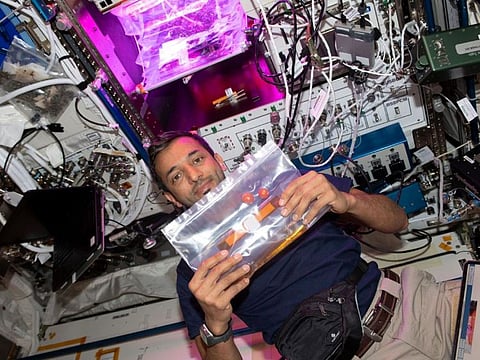MELFI and ANITA on ISS: UAE astronaut Sultan Al Neyadi’s new experiences in space
SpaceX Crew-6 get blueberries, apples, cherry tomatoes and cheese for space diet

Dubai: UAE astronaut Sultan Al Neyadi has added new chapters in his historic space mission by working on an ultra cold lab freezer and a compact gas analyser aboard the International Space Station (ISS).
According to a NASA update, the Expedition 68 crew, including Al Neyadi’s SpaceX Crew-6, focused on cargo operations, science experiments, and maintenance tasks after a SpaceX Commercial Resupply Service Dragon docked to the ISS at 7.31am EDT (4.31pm in the UAE) on Thursday.
The SpaceX CRS-27 Dragon successfully docked to the forward-facing port of the station’s Harmony module, delivering more than 6,200 pounds of research, hardware, and supplies.
The scientific experiments and technology demonstrations carried by the uncrewed Dragon spacecraft examine how the heart changes in space, test a student-designed camera mount, compare surfaces that control biofilm formation, and more.
After the Dragon docked into ISS, Al Neyadi along with NASA Flight Engineers Frank Rubio, Stephen Bowen and Woody Hoburg spent time unloading cargo from the spacecraft, NASA said.
What is MELFI?
“Al Neyadi and Rubio were specifically tasked with unpacking double-cold bags for transporting samples into the station’s Minus Eighty-Degree Laboratory Freezer for ISS (MELFI).”
The MELFI is a cold storage unit that maintains experiment samples at ultra-cold temperatures throughout a mission. MELFI supports a wide range of life science experiments by preserving biological samples (such as blood, saliva, urine, microbial or plant samples) collected aboard ISS for later return and analysis back on Earth, according to NASA.
Samples from the ISS Medical Project will be stored in MELFI and contribute to multiple studies of the effort of space flight on human health.
The cooling system of the Minus Eighty-Degree Laboratory Freezer for ISS (MELFI) is based on the Reverse Brayton Thermodynamic Cycle which uses nitrogen gas as a working fluid.
Although MELFI is techinically capable of operation at any setpoint between 10°C and -99°C, there are three standard operating modes; -95°C, -35°C and 2°C.
Analysis with ANITA
NASA said Al Neyadi also replaced components in the station’s bathroom, also known as the Waste and Hygiene Compartment, before performing a functionality test. He later retrieved an air sample from inside Dragon for analysis with the Analyzing Interferometer for Ambient Air-2 (ANITA-2) device.
ANITA-2 is a compact gas analyser which can analyse and quantify 33 trace contaminants in the atmosphere aboard the ISS automatically. ANITA-2 can also detect the presence of unknown substances which can be evaluated later on the ground.
Detection of unknown substances is possible if they are detectable by infrared light, in which case ground analysis is required.
Results are provided to the ground at least once per day. ANITA-2 serves as a technology demonstration in support of the preparation for human exploration missions beyond low-Earth orbit, according to NASA.
New food supply
NASA has also revealed the food supply delivered by the commercial resupply mission.
“This particular flight is carrying blueberries, apples, cherry tomatoes and four kinds of cheese: sharp cheddar, Asiago, Parmesan, and a cow’s milk cheese rubbed with espresso,” NASA said in a tweet.
“All the makings of a space charcuterie board?” it added in another tweet.
Sign up for the Daily Briefing
Get the latest news and updates straight to your inbox

